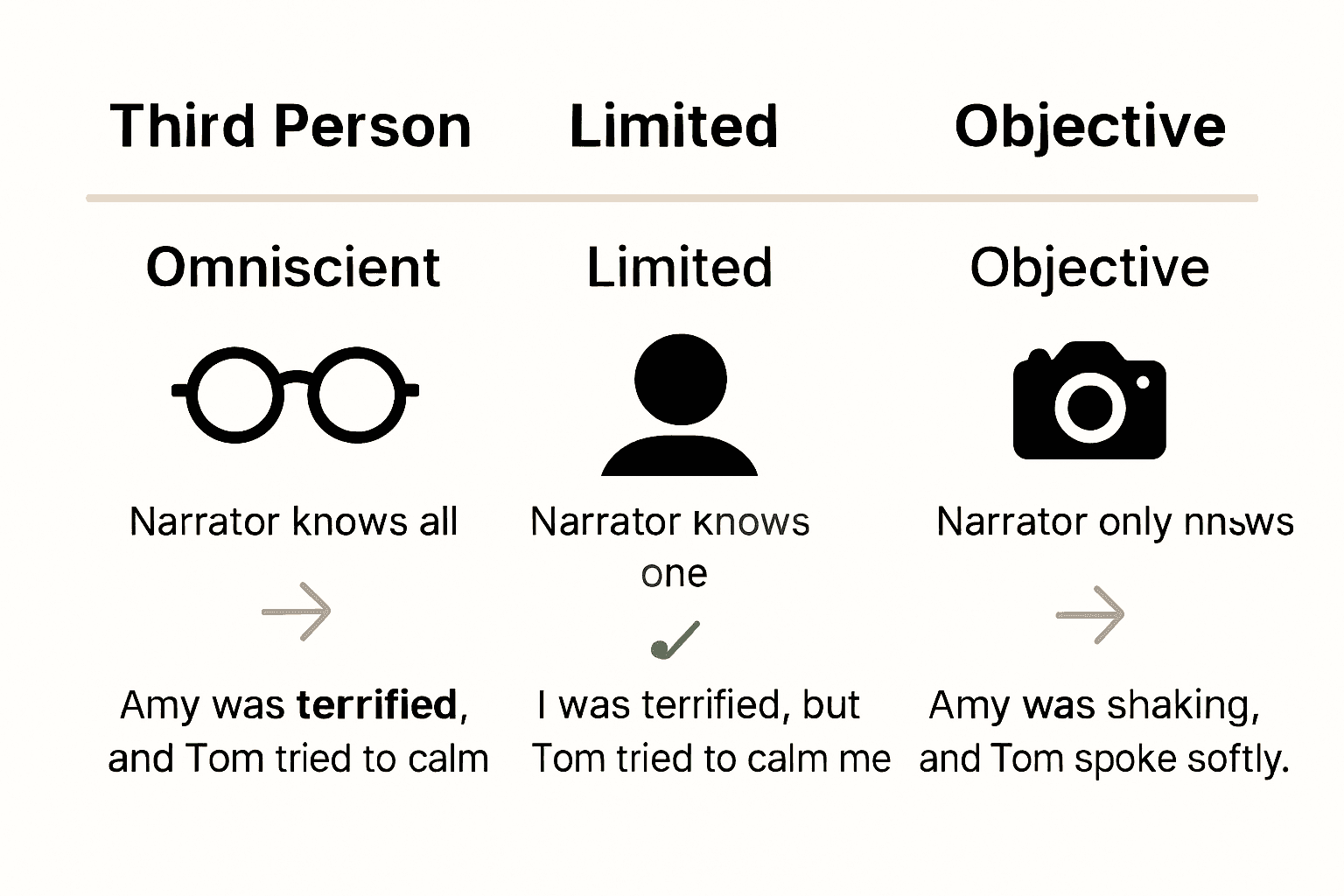Blog
Learning Materials
Complete Guide to Third Person Essay Writing
Updated: October 23, 2025

Did you know that nearly every academic essay relies on third person perspective to achieve a clear, professional tone? Strong writing in third person does more than just follow a rule. It helps readers focus on ideas instead of the writer, which can make arguments and research much more effective. Understanding how and when to use third person perspective lays the groundwork for essays that are both persuasive and respected.
Table of Contents
- Defining Third Person Essay Perspective
- Types of Third Person Narrative Styles
- Key Techniques For Writing In Third Person
- Common Mistakes To Avoid In Third Person Essays
- Comparing Third Person To Other Essay Perspectives
Key Takeaways
| Point | Details |
|---|---|
| Third Person Perspective | Writing in third person enhances objectivity and professionalism by focusing on the subject rather than personal experiences. |
| Types of Third Person Narratives | Three primary styles include omniscient, limited, and objective, each serving different narrative purposes and applications. |
| Key Writing Techniques | Utilize specific pronouns, avoid personal references, and maintain consistency to ensure clarity and professionalism. |
| Common Mistakes to Avoid | Writers should avoid shifting perspectives, using first-person pronouns, and including subjective language to maintain academic integrity. |
Defining Third Person Essay Perspective
Writing an essay in third person perspective means discussing subjects and ideas without directly involving yourself as the narrator. According to Writing Commons, this perspective is designed to direct readers' attention toward the subject being presented, creating an objective and professional tone.
In academic writing, third person perspective involves using specific pronouns and language strategies. As St. Louis Community College explains, this means identifying people by proper nouns or using pronouns like "they," "she," "he," and impersonal terms such as "one," "everyone," and "anyone."
The primary advantages of third person perspective include:
- Maintaining a professional and scholarly tone
- Creating emotional distance from the subject
- Presenting information objectively
- Allowing readers to focus on the content rather than the writer's personal experiences
Most academic disciplines, including research papers, argumentative essays, and scientific reports, rely on third person perspective to ensure clarity, credibility, and intellectual rigor. By removing personal pronouns and subjective language, writers can craft more authoritative and universally accessible texts.

Types of Third Person Narrative Styles
In academic and creative writing, third person narrative styles offer writers nuanced approaches to storytelling and information presentation. According to Her Conversation, there are three primary types of third person perspectives: omniscient, limited, and objective, each with distinct characteristics and applications.
Here's a comparison of the different third person narrative styles:

| Style | Main Focus | Access to Thoughts | Common Usage |
|---|---|---|---|
| Omniscient | Multiple characters | All characters | Novels, epic stories |
| Limited | One character | Single character | Short stories, novels |
| Objective | External events | None (just actions) | Academic writing, journalism |
The omniscient perspective provides a comprehensive "god-like" view of the narrative, allowing writers to access and explore multiple characters' thoughts, motivations, and inner worlds simultaneously. This style enables a broad understanding of the story, revealing insights that individual characters might not perceive or understand.
In contrast, the limited third person perspective focuses on a single character's experience, offering an intimate and deep exploration of their thoughts and emotions while maintaining an external narrative voice. This approach creates a more focused and personal storytelling experience, allowing readers to connect closely with one character's perspective without direct first-person involvement.
The objective third person style functions like a journalistic report, presenting events and actions without revealing internal character emotions or psychological states. This approach maintains strict external observation, describing actions and dialogue without interpreting characters' internal experiences. Writers often use this style in academic writing, research papers, and analytical documents where emotional distance and factual reporting are paramount.
Key Techniques for Writing in Third Person
Writing effectively in third person requires mastering specific linguistic strategies that maintain objectivity and clarity. According to Writing Commons, the fundamental technique involves using specific personal pronouns such as he, she, it, they, him, her, them, his, her, hers, its, their, and theirs to reference subjects without personal involvement.
Consistency is crucial when writing in third person. As St. Louis Community College emphasizes, writers must avoid switching between first, second, and third person perspectives within the same document. This means maintaining a uniform narrative voice throughout your essay to prevent reader confusion and preserve the formal academic tone.
Key techniques for successful third person writing include:
- Using proper nouns and specific names instead of personal references
- Avoiding first-person pronouns like "I" or "we"
- Selecting impersonal pronouns such as "one" or "anyone"
- Constructing sentences that focus on the subject rather than the writer
- Maintaining an objective and neutral tone throughout the text
Professional writing demands precision. By implementing these techniques, writers can create clear, authoritative texts that prioritize the subject matter over personal commentary, ensuring a scholarly and professional communication style that remains engaging and accessible.
Common Mistakes to Avoid in Third Person Essays
Maintaining a consistent and professional third person perspective can be challenging for many writers. According to Human LibreTexts, one of the most critical errors is inconsistent point of view, where writers inadvertently switch between different perspectives within the same piece of writing.
St. Louis Community College emphasizes the importance of perspective consistency, highlighting several common pitfalls that can undermine the quality of academic writing. These mistakes can significantly detract from the essay's professionalism and clarity.
Common mistakes in third person essay writing include:
- Using first-person pronouns like "I" or "me" accidentally
- Shifting between third person and first/second person perspectives
- Overusing personal language or subjective statements
- Failing to maintain an objective and neutral tone
- Including unnecessary personal opinions or experiences
To produce a polished academic essay, writers must remain vigilant about maintaining a consistent third person perspective. This means carefully reviewing the text to eliminate any personal pronouns, subjective language, or perspective shifts that might compromise the essay's academic integrity. Essay Proper Format: Easy Guide for Students and Educators offers additional insights into maintaining a professional writing style that meets academic standards.
Comparing Third Person to Other Essay Perspectives
Understanding the nuanced differences between essay perspectives is crucial for effective academic writing. According to Human LibreTexts, each perspective offers unique advantages and limitations in scholarly communication.
First person perspective allows writers to include personal experiences and direct observations, using pronouns like "I," "me," and "we." In contrast, St. Louis Community College emphasizes that third person perspective provides the most objective approach, enabling writers to maintain professional distance and focus on the subject matter.
Key differences between essay perspectives include:
- First Person: Personal, subjective, uses "I/we"
- Second Person: Directly addresses reader, uses "you"
- Third Person: Objective, academic, uses "he/she/they"
The primary advantages of third person become clear when examining its strengths. Unlike first person, which can feel anecdotal, or second person, which can seem instructional, third person offers a balanced, scholarly approach that prioritizes the subject over the writer's personal experiences. How to Write a Comparative Essay: Tips and Structures provides additional insights into maintaining a professional writing perspective across different academic contexts.
Master Third Person Essay Writing with Smart AI Support
Struggling to maintain a consistent and objective third person perspective in your essays can be frustrating and time-consuming. The article highlights common challenges like avoiding first-person pronouns and ensuring clarity while keeping a professional tone. You want your writing to be authoritative and polished without the stress of constant revision.

Discover how Samwell.ai can transform your essay writing experience. Our AI-powered platform helps you craft essays that strictly follow third person guidelines by providing:
- Customized essay generation aligned with academic standards
- Tools like the 'Power Editor' to refine and expand your content
- Built-in checks for objective language and perspective consistency
Take control of your academic writing journey today. Visit Samwell.ai and start crafting compelling third person essays with confidence and ease.
Frequently Asked Questions
What is third person perspective in essay writing?
Third person perspective in essay writing refers to an objective narrative style that discusses subjects without involving personal pronouns like 'I' or 'we'. It focuses on the subjects and ideas presented, creating a professional and scholarly tone.
What are the advantages of using third person perspective in academic writing?
Using third person perspective in academic writing maintains a professional tone, creates emotional distance from the subject, presents information objectively, and allows readers to focus on the content rather than the writer's personal experiences.
What are the common mistakes to avoid when writing in third person?
Common mistakes include accidentally using first-person pronouns, shifting between perspectives, overusing personal language, failing to maintain an objective tone, and including unnecessary personal opinions or experiences.
How does third person perspective differ from first and second person perspectives?
Third person perspective is objective and uses pronouns like 'he', 'she', or 'they', while first person includes personal involvement with 'I' or 'we', and second person directly addresses the reader with 'you'. Each perspective offers different advantages for communication in writing.
Recommended
- How Do You Write a Personal Essay: Expert Tips
- Essay Type Example: Guide for Students and Educators
- Standard Essay Format Guide for 2025: Structure, Tips, and Examples
- Mastering Essay E: Essential Writing Tips & Examples
Generate essays with Samwell.ai
Whether you’re a publisher, professor, journalist, or student, let us tailor a plan just for you.Most Read Articles

Your Guide to Help Writing a Essay Successfully
Expert tips for help writing a essay - from crafting a thesis to structuring your essay effectively.

How to Write Critical Thinking Essay: Expert Tips
Expert tips for writing a critical thinking essay. Learn how to structure, choose topics, and use evidence effectively.'

How to Write a Good Hook: A Step-by-Step Guide
Master the art of crafting a good hook with our guide. Create compelling openers for a memorable first impression.

